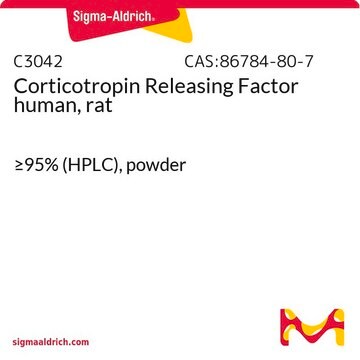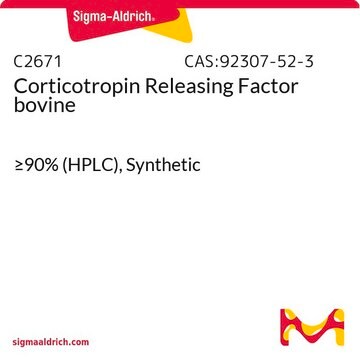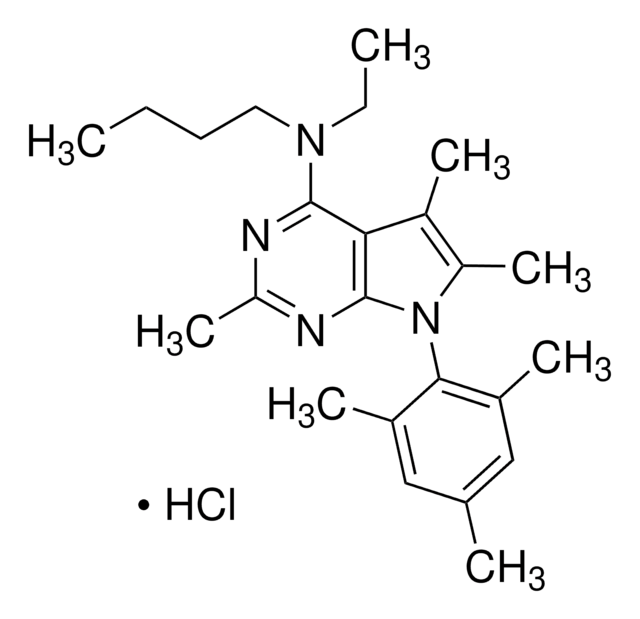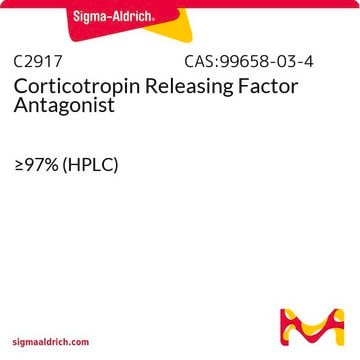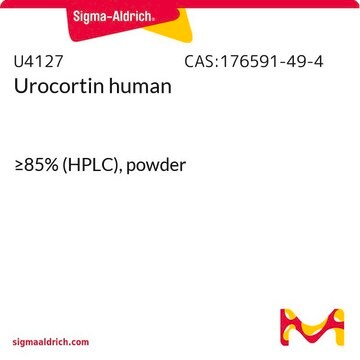C3167
Corticotropin Releasing Factor sheep
≥95% (HPLC)
Sinônimo(s):
CRF, CRH
Faça loginpara ver os preços organizacionais e de contrato
About This Item
Fórmula empírica (Notação de Hill):
C205H339N59O63S
Número CAS:
Peso molecular:
4670.31
Número MDL:
Código UNSPSC:
12352200
NACRES:
NA.32
Produtos recomendados
Procurando produtos similares? Visita Guia de comparação de produtos
Amino Acid Sequence
Ser-Gln-Glu-Pro-Pro-Ile-Ser-Leu-Asp-Leu-Thr-Phe-His-Leu-Leu-Arg-Glu-Val-Leu-Glu-Met-Thr-Lys-Ala-Asp-Gln-Leu-Ala-Gln-Gln-Ala-His-Ser-Asn-Arg-Lys-Leu-Leu-Asp-Ile-Ala-NH2
Ações bioquímicas/fisiológicas
CRF is a hypothalamic peptide that releases ACTH and endorphin from the anterior pituitary. It is also a neurotransmitter in the central nervous system, and is involved in autonomic and endocrine responses to stress.
Releases ACTH and endorphin from the anterior pituitary; central nervous system neurotransmitter.
Outras notas
Lyophilized from 0.1% TFA in H2O
Código de classe de armazenamento
11 - Combustible Solids
Classe de risco de água (WGK)
WGK 3
Ponto de fulgor (°F)
Not applicable
Ponto de fulgor (°C)
Not applicable
Equipamento de proteção individual
Eyeshields, Gloves, type N95 (US)
Escolha uma das versões mais recentes:
Já possui este produto?
Encontre a documentação dos produtos que você adquiriu recentemente na biblioteca de documentos.
Susan K Wood et al.
American journal of physiology. Regulatory, integrative and comparative physiology, 304(11), R940-R950 (2013-04-05)
Barrington's nucleus, in the pons, regulates micturition through spinal projections to preganglionic parasympathetic neurons. The stress neuropeptide CRF is prominent in these projections and has an inhibitory influence. Social stress in rats causes urinary retention and abnormal urodynamics resembling those
L O E Ebbesson et al.
Journal of neuroendocrinology, 23(8), 733-741 (2011-05-20)
Salmon parr-smolt transformation (smoltification) is a mid-life transitional stage between life in freshwater and seawater that entails a wide range of neural, endocrine and physiological modifications. In salmon, the neuroendocrine corticotropin-releasing factor (CRF) system regulates pituitary adrenocorticotrophic hormone and thyrotrophin
Cun Li et al.
Endocrinology, 154(7), 2365-2373 (2013-04-30)
Intrauterine growth restriction (IUGR) is an important fetal developmental problem resulting from 2 broad causes: maternal undernutrition and/or decreased fetal nutrient delivery to the fetus via placental insufficiency. IUGR is often accompanied by up-regulation of the hypothalamo-pituitary-adrenal axis (HPAA). Sheep
Joan M Vaughan et al.
Endocrinology, 154(4), 1553-1564 (2013-03-16)
Mouse (m) and human (h) urocortin 2 (Ucn 2) were identified by molecular cloning strategies and the primary sequence of their mature forms postulated by analogy to closely related members of the corticotropin-releasing factor (CRF) neuropeptide family. Because of the
Xiao-Dong Wang et al.
Nature neuroscience, 16(6), 706-713 (2013-05-07)
Stress impairs cognition via corticotropin-releasing hormone receptor 1 (CRHR1), but the molecular link between abnormal CRHR1 signaling and stress-induced cognitive impairments remains unclear. We investigated whether the cell adhesion molecule nectin-3 is required for the effects of CRHR1 on cognition
Nossa equipe de cientistas tem experiência em todas as áreas de pesquisa, incluindo Life Sciences, ciência de materiais, síntese química, cromatografia, química analítica e muitas outras.
Entre em contato com a assistência técnica